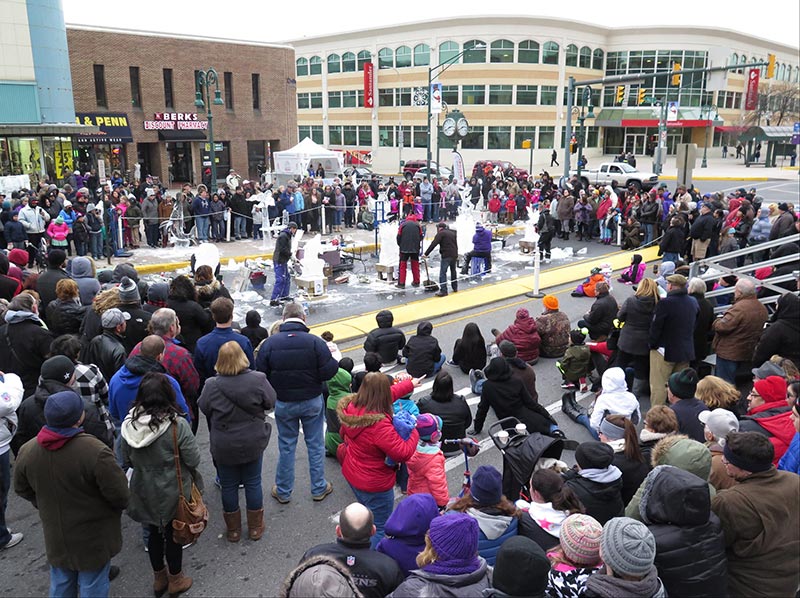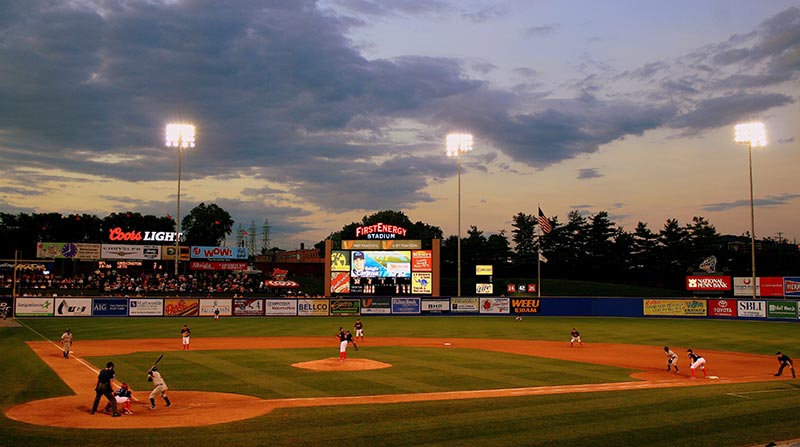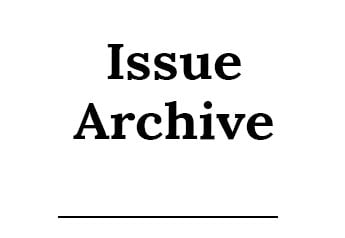When Mayor Eddie Moran considers the arrival of this spring in the City of Reading, he’s thinking about a bunch of bright new beginnings.
And beyond the usual signs of the season, the mayor is also seeing the rebirth, really the revitalization, of Reading, particularly the downtown.
“It has been an exciting time watching Reading bloom so beautifully,” he says. “The transformation we are witnessing in infrastructure – how the traditional merges with the contemporary – and how new investors value our city’s history is simply inspiring.”
The mayor cites key downtown projects.

A New Downtown Dawning
“Without a doubt, CollegeTowne is a tremendous asset to our Downtown Plus Area, and my administration is fully engaged to make sure that other capital projects come to fruition,” Moran says.
CollegeTowne is Alvernia University’s new downtown campus at Fourth and Penn streets that will headquarter its School of Engineering and the O’Pake Institute. The first floor will host retail tenants while student housing will occupy upper floors.
Among the other projects are the expected revelation for the development/redevelopment of the Reading Eagle Company building in the 300 block of Penn Street, the conversion of the Madison Building at Fourth and Washington to market-rate apartments, the conversion of the Berkshire Building at Fifth and Washington to graduate foreign student housing for Alvernia, the conversion (and planned addition to) the Medical Arts Building in the 200 block of N. Fifth Street to apartments or condominiums, and the construction of new townhouses at Third and Washington streets, just east of GoggleWorks Center for the Arts.
Also pending is a new effort by the city to find an innovative developer for its long-languishing buildings on the northwest corner of Fifth and Penn.
Berks County Commissioner Michael Rivera, with a professional background in banking and real estate, agrees that developers, investors and homeowners are seeing city opportunities.
Rivera cites statistics shared by the Reading-Berks Association of Realtors.
“Property values in the city have been going up in the past two to three years,” he says, “and available inventory remains low.”
Indeed, in mid-January, only 80 single-family homes and 22 buildings with two to four units were listed.
Johnathan Savant, R-BAR director of government and community affairs, reports that Reading home prices are compatible for buyers in the median countywide income range.
“This past December, homes in Reading were on the market for a median nine days from the time they were listed before going under contract,” he says. “It is not uncommon to receive multiple offers in the first 24 hours of listing.”
They also note impressive city property statistics: median list price for a city property was $64,000 in January 2019 and climbed to $90,000 by December 2020, a 40.5 percent increase (Berks County median property values rose 16.4 percent in that time). Median sales price was even higher: $65,500 in January 2019 rising to $83,000 in December 2020, a 26.7 percent increase (Berks County median sales prices rose 4 percent in the same period).
On the Rise, Finally
Jaime Perez, a Reading High School graduate and now an agent with Keller Williams Platinum Realty, credits the Our City Reading initiative begun nearly two decades ago by late department store magnate and Reading native Albert Boscov as an early catalyst in improving home values.
“I worked with Mr. Boscov and learned a lot,” he says. Perez is heartened by the efforts of Neighborhood Housing Services, Habitat for Humanity, county and city funding mechanisms, and private developers. The effort, which includes a deconversion of multi-units into single-family homes, has the consequence of better property values all around.
Perez says more aggressive marketing that will rebrand the city and attract more folks from outside the area to see the values and quality of life in Greater Reading is needed.
Rivera attributes the appeal of city properties to affordability compared to major metro areas like Philadelphia, New York and D.C., and its proximity to them, the unique historic architecture, the natural surrounds of parkland (Mount Penn Preserve, the Schuylkill River trails and the county parks system) as well as nearby farmland, and the rise in remote working that began even before the pandemic.
The tradition of Hispanic family members wanting to live near each other has brought thousands of new residents in the past 20 years. Indeed, by Census Bureau estimates, some 60-plus percent of Reading’s residents are Hispanic.
A Hispanic Haven
Centro Hispano, led by Michael Toledo, also a Reading High alumnus, has played a big role in advocating for the burgeoning Hispanic population.
During Census 2020, Centro Hispano assisted more than 600 families it serves with completing their census.
“This will lead to over $20 million in federal investment into our city over the next 10 years,” says Toledo.
Rivera and Toledo note the strong work ethic of city residents working in large businesses like Deka near Topton, the new $80-million Carbonite plastics recycling facility in Muhlenberg, and warehousing in northern Berks and utilizing BARTA public transport routes. The Schmidt Center for Technology at Reading Area Community College provides training for workers changing careers. The three Career and Technology Centers offer high schoolers courses for a jump start in the skilled trades workforce.

Activity in the City Center
The Moran Administration’s developing Downtown Plus Plan will be yet another catalyst in center city’s rise.
Johanny Cepeda-Freytiz, owner of Mi Casa Su Casa in the 300 block of Penn Street, was drawn from New York City to Reading in 2007 by family who settled here.
Her eatery has become a hub of the arts and community activism. Most importantly, her diverse customer base reflects the vitality of the urban core.
“Throughout the years, I have met and served a variety of people,” she says. “I have seen a growth of culturally diverse businesses. Despite economic losses and adversity, I have seen our community come together and create some of the most memorable events and activities downtown. Downtown Reading has become home to the arts, music, food and culture.”
Post-pandemic, Cepeda-Freytiz sees arts events returning, including First Fridays, Top of the Block, the Hip-Hop Summit, the Berks Salsa Fest, the RIZE dance on the street event, the Hispanic Festival and so many more.
Kevin Murphy, president of the Berks County Community Foundation, which has financially supported many downtown events including Downtown Alive and Fire + Ice, says events are critical to bring visitors back to the downtown.
“The Community Foundation has spent many years funding activities that have brought more people and interest into that urban core,” he says. “That strategy has been working and we’re committed to remaining focused on it.”
City Council President Jeff Waltman has an upbeat view, too.
“As we begin to exit Act 47 (financially distressed city status), we are entering an era with a renewed downtown focus that will transform the downtown away from the trials and tribulations of the past 40 years,” he says.
Resources and a Wonder
Reading’s residents and its beauty are its greatest resources, Waltman believes.
“In a city full of wonderful diverse people and amazing children we may simply be one of the wealthiest cities in the country. The time has come to underscore our diversity, history and breathtaking natural beauty to move the city and the region forward.
“As we build that vision together with our Downtown Plus strategic plan let’s remember there are no limitations on what we can achieve, how much success we can have, and how strong our quality of life can be. I am very excited about a ‘new’ Reading. One that we will all be very proud of,” says Waltman.
Two veteran members of the city’s state legislative delegation agree.
“We’ve seen a lot of positive change in Reading over the last 10 years,” says state Senator Judy Schwank. “Some of that change is very visible and has a big impact, like the Penn Street projects including the DoubleTree Hotel, Santander Arena and now Alvernia University’s CollegeTowne.
“Also significant, especially to city residents, are some of the new shopping centers popping up in neighborhoods. Big or small, it’s exciting to see developers and investors recognizing the potential in Reading,” says Schwank.
State Representative Mark Rozzi, a former businessman who represents portions of Reading, offers this thought.
“I have noticed in my time what appears to be an increase in home ownership, which has spurred community revitalization as well as serious increases in home values,” he says. “I see more pride in neighborhoods, better care being taken to homes and cleaner streets.”
Their comments are particularly pertinent to new energy in the city’s south and southwest. Community activists like Tony Veloz and Barrio Alegria, often working in concert with the main branch of the Reading Public Library, have created a new vitality in and identity for “South of Penn” with a variety of cultural events, especially dance and other performing arts. They also do regular clean-ups extending down Fifth Street to Laurel where the Reading Firefighters Museum, based in the old Liberty Fire House, pays homage to the city’s 250-plus-year-old firefighting heritage.
The 18th Wonder initiative has been a gamechanger for the 18th Ward and Millmont communities just across the Bingaman Street Bridge. The Masano auto dealerships, long-time business anchors along Lancaster Avenue, continue there with newly renovated facilities and aesthetics that have beautified city-owned medians. John Masano, a second-generation leader, has spearheaded a huge vehicle sales complex adjacent to Reading Body and Berks Catholic High School, in which he has provided community meeting space.
Establishments like Mimmo’s and Oakbrook Brewing Company complement private clubs like the popular Victor Emmanuel II. A new home for small businesses – as well as a much-needed neighborhood grocery store – is the completely renovated former A.W. Golden building on Lancaster Avenue. Shuman Development Corp., also responsible for successfully renovating a number of downtown and north-central city buildings, accomplished that project.

Good Sports and Faith
Sports, like the arts, play a huge role in providing opportunities for commerce and community. FirstEnergy Stadium, built 70-plus years ago, has been lovingly maintained and improved to meet changing needs with a capacity of 9,000. Home, since 1967, to the Reading Phillies (now Fightins), the stadium has been named “America’s Classic Ballpark” and is the catalyst for the city’s Baseballtown moniker. Nearby Mike’s Tavern in Riverside gained national theatric fame in 2016 as the setting for Sweat, Lynn Nottage’s Pulitzer Prize-winning Broadway play.
Another city stalwart has been its religious institutions.
“The faith community has been woven into the life of Reading since its founding,” says Michael Kaucher, director of development for RBCC/Transformative Solutions Network. “This community, now representing roughly 100 congregations, continually invests in the lives of their neighbors. Many times, it's not just a meal served, but a place where neighbors can gather and be connected. Beyond individual congregations, a number of nonprofit organizations like Hope Rescue Mission and The Salvation Army are operated by the faith community.”
A spiritual symbol to many is the city’s century-old landmark, the Pagoda atop Mount Penn. Though closed to the public due to COVID-19, the amount of activities, including inside rentals will increase when restrictions lift.
Councilwoman Marcia Goodman-Hinnershitz, whose district includes the building, also serves as the Foundation for the Reading Pagoda chair.
“Climbing to the top of the Pagoda has always been a favorite activity for more than 30,000 visitors every year,” she says. “The Foundation is creating a virtual Pagoda walk-through to provide insights into the structure. The Pagoda is nestled in a mountain scape with trails offering first-class hiking and biking opportunities. In the upcoming summer months, outdoor events including concerts will be offered on the Pagoda lawn.”
Getting Educated
Another icon is Reading High School, long affectionately nicknamed the Castle on the Hill.
For too long, the Reading School District, significantly populated with children who live in poverty and in unstable home settings, dealt with high drop-out rates, student transiency and fiscal instability. In the past few years, largely due to the innovative leadership of superintendent Dr. Khalid N. Mumin — recognized as one of the top school superintendents in America — RSD is on the upswing.
The drop-out rate has plunged, and more students than ever are excelling on secondary levels preparing for professional careers and skilled trades. The 2017 Reading High state championship basketball team with star player Lonnie Walker IV, now with the San Antonio Spurs, injected a new and palpable sense of pride throughout the city and in RHS alumni. Like Wilson High graduates and NFL players John Gilmore and Chad Henne who created the Gilmore-Henne Community Fund, Walker has also become a philanthropist with his Lonnie Walker IV Foundation aiding city youth.
Wesley S. Butler was a Walker teammate and RHS basketball team captain for three years. A 2019 RHS graduate, he’s a Kutztown University sophomore majoring in communications and is a basketball standout. His face graces many KU billboards highlighting outstanding local students.
At 20, he is following his dad, Wynton Butler, RSD director of Social Services, and his mom, Magisterial District Justice Tonya Butler, into public service. One of the youngest candidates to seek a City Council seat, he seeks to spread his pride and love in Reading.
He says the 2017 celebratory parade down N. 13th Street feting the state championship was one of the most memorable days of his life. He also believes it marks the time when the hometown pride switch was turned on, the start of a changed and positive image for the city.
“We were really a team,” he says. “My team was a part of accomplishing a goal – the state championship that had never been done before. We took care of the winning, but it wouldn’t have happened without the city folks in the role of supporting us.
“That day, that parade, was the best thing I’ve seen in my life,” he says. “My hope is that we take that energy and create a clean and safer environment where all the community is involved.”
The mayor agrees with his assessment.
“Community participation is vital,” says Moran. “We could use more community leaders who can attract more investors and, as a result, contribute to the city’s growth.”
Editor’s note: Donna Reed is a member of the City of Reading City Council and also a board member of the Foundation for the Reading Pagoda.

















